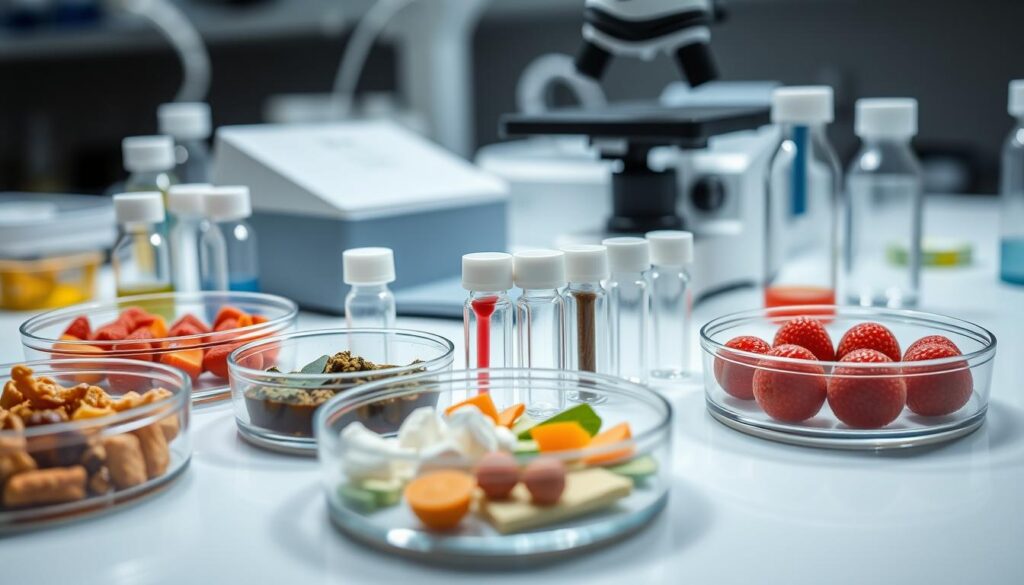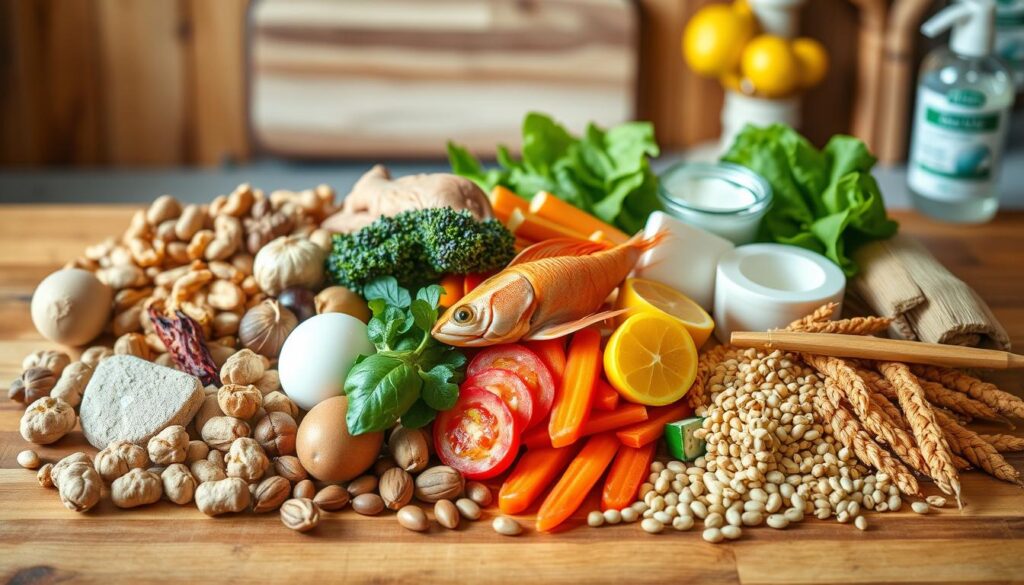In today’s world, knowing about food allergies is key. The culinary scene is diverse, and allergens can be hidden. But don’t worry! We’ll cover the basics of food allergens, their health effects, and how to stay safe.
How common are food allergies, and which foods are most often to blame? Knowing the signs of an allergic reaction is crucial. Also, understanding the difference between an allergy and intolerance is important. And, being ready for anaphylaxis, a serious condition, is essential. Get ready to learn how to protect yourself and your family.
Key Takeaways
- Discover the most prevalent food allergens and their potential impact on health
- Learn to differentiate between food allergies and intolerances, and recognize the signs of an allergic reaction
- Understand the risks of anaphylaxis and the critical steps to take in an emergency
- Explore strategies for reading food labels, identifying hidden allergens, and preventing cross-contamination
- Gain insights on navigating dining out, managing your kitchen, and leveraging technology to enhance food safety
What Are Food Allergens and Their Impact on Health
Food allergens are proteins in foods that can cause an immune system reaction. People with food allergies may experience symptoms from mild to severe. It’s important to know about food allergens and their health effects to stay safe.
Common Symptoms of Food Allergic Reactions
The symptoms of a food allergy can vary. Some common ones include:
- Hives, itching, or rash
- Swelling of the lips, face, tongue, and throat
- Difficulty breathing, wheezing, or coughing
- Nausea, vomiting, or abdominal pain
- Dizziness, lightheadedness, or fainting
Difference Between Food Allergy and Intolerance
It’s key to know the difference between a food allergy and intolerance. A food allergy involves the immune system and can be life-threatening. On the other hand, a food intolerance is a digestive issue that’s not life-threatening.
Understanding Anaphylaxis Risk
Anaphylaxis is a severe allergic reaction that can be deadly. It happens quickly and needs immediate treatment. Knowing the signs of anaphylaxis and having a plan is crucial for those with food allergies.

Getting tested for allergens and working with doctors can help manage food allergies. This way, we can reduce the risk of severe reactions. Understanding food allergens helps us stay safe and healthy.
The Big Eight Major Food Allergens
There are a few main culprits behind most food allergies. These are called the “Big Eight” major food allergens. Knowing them is key for reading food labels and avoiding cross-contamination in cooking.
The Big Eight food allergens are:
- Milk
- Eggs
- Peanuts
- Tree nuts (such as almonds, walnuts, and cashews)
- Wheat
- Soy
- Fish
- Crustacean shellfish (such as shrimp, crab, and lobster)
These eight allergens cause over 90% of food allergy reactions. Learning about these common allergens helps you spot them on labels. This way, you can avoid them and lower the risk of a serious allergic reaction.
| Allergen | Common Sources | Potential Hidden Sources |
|---|---|---|
| Milk | Dairy products, baked goods, sauces | Processed meats, chocolate, non-dairy creamers |
| Eggs | Baked goods, mayonnaise, custards | Pasta, breading, and some processed foods |
| Peanuts | Peanut butter, candy, baked goods | Asian dishes, sauces, and some unexpected snacks |
| Tree Nuts | Nuts, nut butters, baked goods | Cereals, granola, and some sauces and dressings |
| Wheat | Bread, pasta, baked goods | Processed meats, sauces, and some condiments |
| Soy | Tofu, soy sauce, edamame | Processed meats, baked goods, and Asian dishes |
| Fish | Seafood, sushi, fish-based sauces | Caesar dressing, Worcestershire sauce, and some imitation seafood |
| Crustacean Shellfish | Shrimp, crab, lobster, and other shellfish | Surimi (imitation crab), seafood flavored chips, and some sauces |
By knowing these common allergens and where they hide, you can avoid them in your diet. This helps reduce the risk of food labeling and cross-contamination.

“Knowing the Big Eight allergens and where they may be hiding can be a game-changer for those with food allergies. It empowers us to make informed choices and stay safe.”
Reading and Understanding Food Labels for Allergens
Reading food labels can be tough, especially for those with food allergies. But, it’s key to stay healthy and safe. Let’s look at FDA labeling rules, hidden allergens, and what advisory statements mean.
FDA Labeling Requirements
The FDA says the top eight food allergens must be labeled clearly. These are milk, eggs, peanuts, tree nuts, wheat, soy, fish, and crustacean shellfish. This makes it easier for people with allergies to spot potential dangers.
Hidden Allergen Sources in Ingredients
- Milk-derived ingredients like casein, whey, and lactose can be hidden sources of dairy allergens.
- Wheat-based ingredients like gluten, flour, and semolina may pose a risk for those with wheat allergies.
- Soy can be present in unexpected places, such as lecithin or hydrolyzed vegetable protein.
Advisory Statements and What They Mean
Food makers sometimes add advisory statements. These say things like “May contain [allergen]” or “Produced in a facility that also processes [allergen].” They warn of possible cross-contamination risks for those with allergies.
| Advisory Statement | Explanation |
|---|---|
| “May contain [allergen]” | The product may have trace amounts of the allergen because of shared equipment or facility. |
| “Produced in a facility that also processes [allergen]” | The product is made in a place that also handles the allergen, raising cross-contamination risks. |
Knowing about food labels and hidden allergens helps you shop safely. Always read labels well and talk to your doctor if you’re unsure.
Cross-Contamination Prevention Strategies
Keeping food safe is very important, especially for people with food allergies. Cross-contamination is a big threat, where allergens get mixed into other foods. Luckily, we can use some simple steps to stop this and make eating safer.
Cleaning and sanitizing all food areas, tools, and equipment is a must. This removes any allergens that might ruin your meal. When cooking, use separate tools and spaces for foods without allergens to keep them safe.
- Thoroughly clean and sanitize all food preparation surfaces, utensils, and equipment.
- Dedicate specific tools, pans, and cooking spaces for allergen-free foods.
- Avoid cross-contact by preparing allergen-free items first, before moving on to other dishes.
Another good idea is to make food safety items first. Start with dishes that don’t have allergens, then make those that do. This way, you lower the risk of allergens getting mixed in. When eating out, tell the staff about your allergies and ask how they handle food.
Preventing cross-contamination is the single most important step in keeping food allergens at bay and ensuring a safe dining experience.” – Food Allergy Research & Education (FARE)
By using these cross-contamination prevention strategies, we can greatly lower the risk of allergic reactions. Being careful and taking steps ahead of time is crucial for food safety for those with allergies.
Managing Food Allergens in Your Kitchen
Making your kitchen safe from food allergens is key for your family’s health. Simple steps can help avoid common allergens like peanuts, tree nuts, dairy, and gluten. Let’s explore how to make your kitchen a safe place for everyone.
Safe Food Storage Tips
Storing food right is the first step to avoid cross-contamination. Use separate shelves or containers for foods with allergens. Make sure to label everything clearly and use airtight containers to prevent spills.
Cleaning and Sanitization Protocols
Cleaning and sanitizing your kitchen is vital. Use special cleaners for surfaces, utensils, and equipment. Regularly deep clean high-risk spots like the stovetop and sink to remove allergens.
Separate Cooking Tools and Spaces
Use separate tools and areas for cooking without allergens. Get color-coded or labeled items like cutting boards and knives. This way, you can avoid mixing allergen-free and allergen-containing foods. Set aside a specific area for preparing allergen-free meals.
Following these tips will make your kitchen safe and allergen-free. You’ll be able to cook with confidence, knowing you’re making healthy meals for your family and guests. Food safety and allergen-free cooking are crucial for everyone’s health and happiness.
Dining Out with Food Allergies
Going out to eat with food allergies can seem tough, but it’s not impossible. With some planning and the right steps, you can have a great time eating out. Here are some tips to make your dining experience better.
Talking to the staff is very important. Tell them about your food allergies when you get to the restaurant. This helps the kitchen avoid any problems and makes sure your food is safe. Remember, restaurant allergy protocols are there to keep you safe, so don’t be shy.
Picking the right place to eat is also key. Look for restaurants that are good at handling food allergies. Check their menu online or call them to see if they can make something safe for you.
- Ask about the staff’s training on handling food allergies.
- Inquire about the kitchen’s ability to accommodate your specific needs.
- Request a detailed review of the menu to identify safe choices.
When you order, be clear and check your order with the server. Tell them exactly how to make your meal and ask about any risks. A little extra care makes sure you have a good and safe time.
| Restaurant Allergy-Friendly Features | Dining Out Allergy Checklist |
|---|---|
|
|
With these tips, you can enjoy eating out safely and happily. Always remember, your safety and happiness are the most important things. So, don’t be afraid to speak up and let them know what you need.
Emergency Response and Treatment Options
Being ready for allergic reactions is key when it comes to food allergies. We’ll cover the important steps to handle emergency situations well.
Using Epinephrine Auto-Injectors
An epinephrine auto-injector is a lifesaver for severe allergic reactions, or anaphylaxis. We’ll show you how to use these devices correctly. This way, you can act fast and confidently in emergencies.
Creating an Emergency Action Plan
Having a personal emergency plan is crucial for food allergy management. We’ll talk about what this plan should include. This includes recognizing allergic reaction signs, what to do next, and who to call for help.
When to Seek Medical Help
Knowing when to get medical help is vital. We’ll explain the signs that mean you need emergency care. This way, you can get the right epinephrine autoinjector and anaphylaxis treatment quickly.
Being ready and knowing what to do in an emergency is crucial. By learning these skills, you’ll feel confident in handling life-threatening situations. This will help keep you or your loved ones safe.
Proper emergency preparedness can be the difference between life and death for those with severe food allergies.”
Using Food Scan Genius App for Allergen Detection
Food allergies are now easier to manage with the Food Scan Genius app. This app lets you scan barcodes to find out about food allergens and nutrition. It gives you quick access to info on thousands of products.
The app helps you control your diet. It checks ingredients for allergens and alerts you to any dangers. This keeps your meals safe and fun.
The Food Scan Genius app does more than just check for allergens. It shows detailed nutrition facts. This helps you choose foods that fit your diet and health goals. Plus, it offers personalized food suggestions just for you.
FAQ
What are food allergens and how do they impact health?
Food allergens are proteins in certain foods that can trigger an immune response. This can cause symptoms ranging from mild discomfort to severe reactions like anaphylaxis. Knowing about common allergens is key to managing food allergies and intolerances.
What are the differences between food allergies and intolerances?
Food allergies involve the immune system and can cause severe reactions. Food intolerances are digestive issues that may cause discomfort but are not life-threatening. Knowing the type of reaction you have is important for managing your condition.
What are the eight major food allergens?
The eight major food allergens are: milk, eggs, peanuts, tree nuts, wheat, soy, fish, and crustacean shellfish. Knowing these allergens is crucial for reading food labels and avoiding cross-contamination.
How can I read and understand food labels for allergens?
The FDA requires that the eight major allergens be clearly labeled on food packaging. Look for specific allergen statements and hidden sources in the ingredient list. Advisory statements like “may contain” can also provide important information about potential cross-contamination risks.
How can I prevent cross-contamination in my kitchen?
To prevent cross-contamination, thoroughly clean all surfaces, utensils, and equipment. Store allergen-containing foods separately. Designate specific cooking spaces and tools for allergen-free meal preparation to minimize risks.
What are some tips for managing food allergens in my kitchen?
To create an allergen-safe kitchen, follow best practices for food storage, cleaning, and meal preparation. Properly label and store allergen-containing items, use dedicated cooking tools, and sanitize surfaces to eliminate cross-contamination. These steps will help you maintain a controlled environment and minimize the risk of accidental exposure.
How can I dine out safely with food allergies?
Dining out with food allergies requires proactive communication with restaurant staff. Research allergy-friendly establishments, ask detailed questions about ingredients and cooking procedures, and be prepared to make special requests. With the right precautions, you can enjoy safe and delicious meals away from home.
What should I do in the event of an allergic reaction?
In the case of a severe allergic reaction, such as anaphylaxis, act quickly. Know how to properly use an epinephrine auto-injector, and have an emergency action plan in place. Seek immediate medical attention if symptoms persist or worsen, as prompt treatment can be life-saving.
How can the Food Scan Genius app help with allergen management?
The Food Scan Genius app offers a powerful tool for allergen detection and dietary management. By scanning barcodes, it can provide detailed information about a product’s ingredients and potential allergens. This innovative technology can help you make informed, safe food choices and navigate the challenges of living with food allergies.





